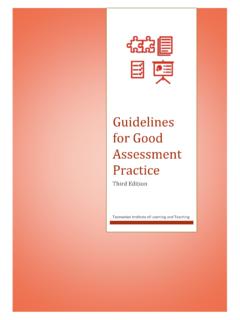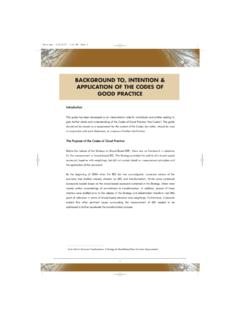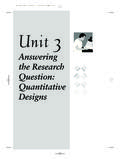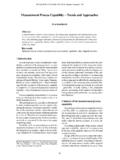Transcription of A NATIONAL MEASUREMENT GOOD PRACTICE GUIDE No
1 A NATIONAL MEASUREMENT good PRACTICE GUIDE for the MEASUREMENT of Smooth Surface Topography using Coherence Scanning InterferometryA NATIONAL MEASUREMENT good PRACTICE GUIDE for the MEASUREMENT of Smooth Surface Topography using Coherence Scanning Interferometry MEASUREMENT good PRACTICE GUIDE No. 108 GUIDE to the MEASUREMENT of Smooth Surface Topography using Coherence Scanning Interferometry Richard Leach NATIONAL Physical Laboratory Leigh Brown, Xiangqian Jiang University of Huddersfield Roy Blunt IQE Ltd Mike Conroy, Darian Mauger Taylor Hobson Ltd ABSTRACT This GUIDE describes good PRACTICE for the MEASUREMENT and characterisation of smooth surface topography using coherence scanning interferometry (commonly referred to as vertical scanning white light interferometry). The GUIDE is based on the MEASUREMENT of the topography of semiconductors, epitaxial wafers and optical thin film coatings.
2 However, the general guidelines described here can be applied to many flat, smooth surface topography measurements. For the purpose of this GUIDE , the definition of a smooth surface is one that has an approximately random distribution of heights with a roughness (Sz) of less than 50 nm. Crown copyright 2008 Reproduced with the permission of the Controller of HMSO and the Queen's Printer for Scotland ISSN 1368-6550 NATIONAL Physical Laboratory Hampton Road, Teddington, Middlesex, TW11 0LW Acknowledgements This document has been produced and funded by the UK Department of Trade and Industry s Applied Research Programme Micro and Nanotechnology Manufacturing Initiative, Project SOLADIM. Thanks also to Dr Tony Smith and Danny Mansfield (Taylor Hobson), Prof Liam Blunt (University of Huddersfield), Dr Mike Walls (Applied Multilayers), David Flack and Chris Jones (NPL), Dr Erik Novak (Veeco), Dr Carol Daniel (Lambda Photometrics) and Dr Ted Vorburger (NIST) for contributing and suggesting improvements to this GUIDE .
3 I Contents 1 Scope of this GUIDE .. 2 Introduction to coherence scanning interferometers .. 3 Basics of interferometry .. 3 Coherence scanning interferometry .. 5 Interferometer objective lenses .. 8 Terms and definitions .. 11 General terms used in this GUIDE .. 12 Surface profile 12 Areal surface texture MEASUREMENT .. 12 Sampling area .. 12 Coherence scanning interferometry .. 13 Numerical aperture .. 13 User defined variables .. 14 Smooth surface .. 14 Areal surface texture parameters .. 14 Areal and profile parameters .. 15 Amplitude parameters .. 16 Spacing parameters .. 19 Hybrid parameters .. 20 Filtering techniques .. 21 Scale-limited surfaces .. 21 ii Gaussian filtering and 22 MEASUREMENT preparation and instrument setup .. 25 MEASUREMENT sample preparation and instrument setup .. 26 Handling of calibration artefacts.
4 26 Instrument calibration .. 26 Types of 26 The effect of the magnification of the objective lens .. 28 The effect of optical zoom .. 29 Use of digital zoom .. 29 Mode of MEASUREMENT .. 29 Fringe set up (levelling the sample) .. 29 Focus .. 30 Light source and its effect .. 30 Number of averaged measurements .. 31 MEASUREMENT optimisation settings .. 31 Signal to noise threshold .. 31 Data 31 MEASUREMENT speed .. 31 Environmental 32 Positioning the 32 Clean area .. 32 Draughts .. 32 Temperature 32 32 MEASUREMENT limitations when using coherence scanning interferometry .. 33 iii Sources of error in coherence scanning interferometry .. 33 Effect of optical properties of the surface being measured .. 34 Effect of the surface roughness of the surface being measured .. 35 Making measurements and interpreting results .. 37 Sample preparation and handling.
5 38 Fixturing .. 38 38 Metal coating of a sample .. 38 Sample 39 Location and number of measurements .. 39 Case study SOLADIM .. 39 Background and 40 Significant 41 good PRACTICE .. 44 MEASUREMENT processing .. 44 47 Links to other useful sources of 48 NATIONAL and international 48 Networks .. 49 51 Training courses .. 51 International standards .. 52 Literature .. 54 iv List of tables Table 1. Variables investigated as part of the SOLADIM case study ..40 v List of figures Figure 1. Schematic graph of amplitude against time showing constructive interference ..4 Figure 2. Schematic graph of amplitude against time showing destructive interference ..4 Figure 3. Constructive interference from one light source ..5 Figure 4. A typical CSI Figure 5. Schematic of how to build up an interferogram on a surface using CSI. The vertical lines are intensity profiles at the image sensor.
6 6 Figure 6. Commercially available coherence scanning interferometers. Clockwise from bottom left: Mahr, Phase Shift, Polytec, Taylor Hobson, Veeco, Fogale and Figure 7. Schematic of a Mirau Figure 8. Schematic of a Michelson Figure 9. Example of the result of a profile Figure 10. Example of the result of an areal surface texture MEASUREMENT ..13 Figure 11. Illustration of the numerical aperture of a CSI objective lens ..14 Figure 12. Profiles showing the same Ra with differing height Figure 13. A profile taken from a 3D MEASUREMENT shows the possible ambiguity of 2D MEASUREMENT and characterisation ..16 Figure 14. An epitaxial wafer surface topographies in different transmission bands: (a) the raw measured surface; (b) roughness surface (short scale SL-surface) S-filter = m (sampling space), L-filter = 8 m); (c) wavy surface (middle scale SF-surface) S-filter = 8 m, F-operator; and (d) form error surface (long scale form surface), F-operator.
7 23 Figure 15. Result of the MEASUREMENT of a grid type calibration artefact ..27 Figure 16. A MEASUREMENT of a step height artefact ..28 Figure 17. The effect of field dependent dispersion on the MEASUREMENT of a sinusoidal grating ..33 Figure 18. A square wave grating that shows the batwing effect at the step edges ..34 vi Figure 19. Variation in Sq with change in MEASUREMENT Figure 20. Change in surface topography with variation in MEASUREMENT variable ..43 good MEASUREMENT PRACTICE There are six guiding principles to good MEASUREMENT PRACTICE that have been defined by NPL. They are: The Right Measurements: Measurements should only be made to satisfy agreed and well-specified requirements. The Right Tools: Measurements should be made using equipment and methods that have been demonstrated to be fit for purpose.
8 The Right People: MEASUREMENT staff should be competent, properly qualified and well informed. Regular Review: There should be both internal and independent assessment of the technical performance of all MEASUREMENT facilities and procedures. Demonstrable Consistency: Measurements made in one location should be consistent with those made elsewhere. The Right Procedures: Well-defined procedures consistent with NATIONAL or international standards should be in place for all measurements. Introduction IN THIS CHAPTER 11 Scope of this GUIDE Introduction to coherence scanning interferometers 2 Chapter 1 Scope of this GUIDE The purpose of this good PRACTICE GUIDE is to assist users in the effective MEASUREMENT and analysis of smooth surfaces using the technique of coherence scanning interferometry (CSI).
9 The GUIDE will cover the concepts of CSI, the route to repeatable and reliable MEASUREMENT , an overview of appropriate analysis techniques and a GUIDE to the interpretation of results. Throughout the GUIDE the arbitrary definition of a smooth surface is one that has an approximately random distribution of heights with a roughness (Sz, see chapter 2) of less than 50 nm. Note that a further good PRACTICE GUIDE (available in early 2008) will be concerned with the MEASUREMENT of rough and structured surfaces. That GUIDE will go into much more depth on the theory and PRACTICE of interferometry and should be consulted where non-smooth surfaces need to be measured. Semiconductor and Optical Layer Analysis and Definition using Interference Microscopy (SOLADIM) was a project funded by the MNT Manufacturing Initiative of the UK Department of Trade and Industry (2004 to 2007).
10 The aim of the project was to develop MEASUREMENT techniques and international specifications for surface texture MEASUREMENT of epitaxial wafers and thin film coatings. good PRACTICE GUIDE no. 108 was compiled during the SOLADIM project to specifically look at the MEASUREMENT of epitaxial wafers and thin film coatings, however, the principles can be applied to the MEASUREMENT and characterisation of many flat and smooth surfaces. Throughout this GUIDE we will concentrate on the use of coherence scanning interferometers. However, the generic principles of MEASUREMENT good PRACTICE can be applied to many surface texture measuring instruments. During the formulation of this GUIDE and development of the case study the Taylor Hobson Talysurf Coherence Correlation Interferometer (CCI) was used primarily.














